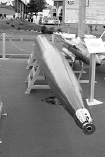068
SS Great Britain, Bristol, England
 51° 26′ 56.99″ N, 2° 36′ 30.12″ W
51° 26′ 56.99″ N, 2° 36′ 30.12″ W
![]()
![]()
![]()
Iron Hulled and Propeller Powered
The ship SS Great Britain (Figure 68-1) was launched in 1843 and was, at the time, the largest ship ever built. Designed primarily by Isambard Kingdom Brunel (see Chapter 70), she had two major innovations: the hull was made of iron, and the ship was powered by a propeller instead of paddle wheels.

Figure 68-1. The SS Great Britain today;
courtesy of the SS Great Britain Trust/Mandy Reynolds
The SS Great Britain sailed from 1843 until 1886, crossing the Atlantic in record time on her maiden voyage in 1845 and later serving as an emigration ship taking people from Great Britain to Australia. In 1886, she was abandoned in the Falkland Islands after an on-board fire, and was used to store coal until she was scuttled in 1937.
In 1970, the ship was refloated on a pontoon and returned to Bristol, to the very dry dock where she had been built. After extensive work to repair, preserve, and restore the ship, the SS Great Britain is now a superb tourist attraction, with a wonderful illusion that keeps the ship dry yet makes it appear to be afloat.
The iron hull corroded badly in the Falkland Islands, and would have continued to corrode in the high humidity found in Bristol (especially in the old, slightly leaky dry dock). To prevent further degradation, the dry dock has been covered over, and the lower part of the ship is kept desert-dry by large dehumidifiers. The dock cover is filled with water, so that to visitors above the water line the ship appears to be afloat.
At the same time, visitors can enter the dehumidified section and view the ship from below. So visiting the SS Great Britain means seeing the entire ship—it’s a unique experience, covering the interior and decks, the exterior from above and below water, the propeller, and the engines.
The ship’s original engine was destroyed, so the restorers built a full-scale replica in its place. The replica doesn’t steam, but it does move, giving an idea of the power of the ship’s original 1,000-horsepower, four-cylinder, V-formation engine. Each cylinder is 2.2 meters across, and originally drove a crankshaft that was the largest forged object in the world in 1843.
Even the ship’s boiler was grandiose. It contained 180 tonnes of sea water that would be boiled to power the engine. Heat came from 1,000 tonnes of coal aboard the ship.
Today, free audio tours are available with a range of different subjects; the most interesting for the science-minded is the “Maritime Archaeologist” tour. The interior of the ship has been staged to give an idea of life aboard a luxury ocean liner in 1843, but for technologists the real excitement lies in the engine room and below the water line.
Isambard Kingdom Brunel also built the Clifton Suspension Bridge in Bristol, which is also well worth a visit. Guided tours are available.
Practical Information
The SS Great Britain has its own website at http://www.ssgreatbritain.org/, as does the Clifton Suspension Bridge at http://www.clifton-suspension-bridge.org.uk/.

